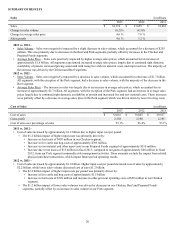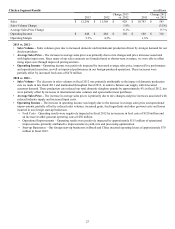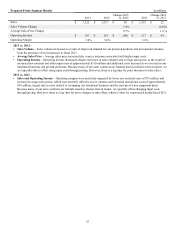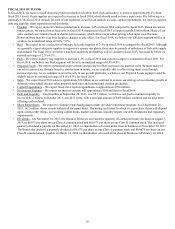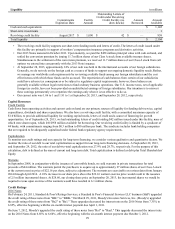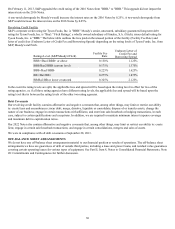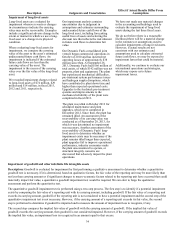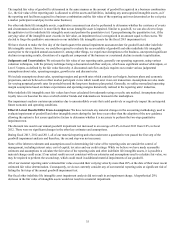Tyson Foods 2013 Annual Report Download - page 29
Download and view the complete annual report
Please find page 29 of the 2013 Tyson Foods annual report below. You can navigate through the pages in the report by either clicking on the pages listed below, or by using the keyword search tool below to find specific information within the annual report.
29
Liquidity in millions
Commitments
Expiration Date Facility
Amount
Outstanding Letters of
Credit under Revolving
Credit Facility (no
draw downs) Amount
Borrowed Amount
Available
Cash and cash equivalents $ 1,145
Short-term investments 1
Revolving credit facility August 2017 $ 1,000 $ 42 $ — 958
Total liquidity $ 2,104
• The revolving credit facility supports our short-term funding needs and letters of credit. The letters of credit issued under
this facility are primarily in support of workers’ compensation insurance programs and derivative activities.
• Our 2013 Notes matured in October 2013. Upon maturity, we paid the $458 million principal value with cash on hand, and
settled the conversion premium by issuing 11.7 million shares of our Class A stock from available treasury shares.
Simultaneous to the settlement of the conversion premium, we received 11.7 million shares of our Class A stock from call
options we entered into concurrently with the 2013 Note issuance.
• At September 28, 2013, approximately 34% of our cash was held in the international accounts of our foreign subsidiaries.
Generally, we do not rely on the foreign cash as a source of funds to support our ongoing domestic liquidity needs. Rather,
we manage our worldwide cash requirements by reviewing available funds among our foreign subsidiaries and the cost
effectiveness with which those funds can be accessed. The repatriation of cash balances from certain of our subsidiaries
could have adverse tax consequences or be subject to regulatory capital requirements; however, those balances are
generally available without legal restrictions to fund ordinary business operations. Our U.S. income taxes, net of applicable
foreign tax credits, have not been provided on undistributed earnings of foreign subsidiaries. Our intention is to reinvest
these earnings permanently or to repatriate the earnings only when it is tax effective to do so.
• Our current ratio was 1.86 to 1 and 1.91 to 1 at September 28, 2013, and September 29, 2012, respectively.
Capital Resources
Credit Facility
Cash flows from operating activities and current cash on hand are our primary sources of liquidity for funding debt service, capital
expenditures, dividends and share repurchases. We also have a revolving credit facility, with a committed maximum capacity of
$1.0 billion, to provide additional liquidity for working capital needs, letters of credit and a source of financing for growth
opportunities. As of September 28, 2013, we had outstanding letters of credit totaling $42 million issued under this facility, none of
which were drawn upon, which left $958 million available for borrowing. Our revolving credit facility is funded by a syndicate of
44 banks, with commitments ranging from $0.3 million to $90 million per bank. The syndicate includes bank holding companies
that are required to be adequately capitalized under federal bank regulatory agency requirements.
Capitalization
To monitor our credit ratings and our capacity for long-term financing, we consider various qualitative and quantitative factors. We
monitor the ratio of our debt to our total capitalization as support for our long-term financing decisions. At September 28, 2013,
and September 29, 2012, the ratio of our debt-to-total capitalization was 27.9% and 28.7%, respectively. For the purpose of this
calculation, debt is defined as the sum of current and long-term debt. Total capitalization is defined as debt plus Total Shareholders’
Equity.
Warrants
In September 2008, in conjunction with the issuance of convertible bonds, we sold warrants in private transactions for total
proceeds of $44 million. The warrants permit the purchasers to acquire up to approximately 27 million shares of our Class A stock
at the current exercise price of $22.16 per share, subject to adjustment. The warrants are exercisable on various dates from January
2014 through April 2014. A 10% increase in our share price above the $22.16 warrant exercise price would result in the issuance
of 2.5 million incremental shares. At $28.60, our closing share price on September 28, 2013, the incremental shares we would be
required to issue upon exercise of the warrants would have resulted in 6.1 million shares.
Credit Ratings
2016 Notes
On February 24, 2011, Standard & Poor's Ratings Services, a Standard & Poor's Financial Services LLC business (S&P) upgraded
the credit rating of these notes from "BB+" to "BBB-." On March 29, 2011, Moody's Investors Services, Inc. (Moody's) upgraded
the credit rating of these notes from "Ba2" to "Ba1." These upgrades decreased the interest rate on the 2016 Notes from 7.35% to
6.85%, effective beginning with the six-month interest payment due April 1, 2011.
On June 7, 2012, Moody's upgraded the credit rating of these notes from "Ba1" to "Baa3." This upgrade decreased the interest rate
on the 2016 Notes from 6.85% to 6.60%, effective beginning with the six-month interest payment due October 1, 2012.



